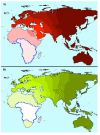The effect of ancient population bottlenecks on human phenotypic variation
- PMID: 17637668
- PMCID: PMC1978547
- DOI: 10.1038/nature05951
The effect of ancient population bottlenecks on human phenotypic variation
Abstract
The origin and patterns of dispersal of anatomically modern humans are the focus of considerable debate. Global genetic analyses have argued for one single origin, placed somewhere in Africa. This scenario implies a rapid expansion, with a series of bottlenecks of small amplitude, which would have led to the observed smooth loss of genetic diversity with increasing distance from Africa. Analyses of cranial data, on the other hand, have given mixed results, and have been argued to support multiple origins of modern humans. Using a large data set of skull measurements and an analytical framework equivalent to that used for genetic data, we show that the loss in genetic diversity has been mirrored by a loss in phenotypic variability. We find evidence for an African origin, placed somewhere in the central/southern part of the continent, which harbours the highest intra-population diversity in phenotypic measurements. We failed to find evidence for a second origin, and we confirm these results on a large genetic data set. Distance from Africa accounts for an average 19-25% of heritable variation in craniometric measurements-a remarkably strong effect for phenotypic measurements known to be under selection.
Figures




Similar articles
-
Genomic and cranial phenotype data support multiple modern human dispersals from Africa and a southern route into Asia.Proc Natl Acad Sci U S A. 2014 May 20;111(20):7248-53. doi: 10.1073/pnas.1323666111. Epub 2014 Apr 21. Proc Natl Acad Sci U S A. 2014. PMID: 24753576 Free PMC article.
-
Distance from Africa, not climate, explains within-population phenotypic diversity in humans.Proc Biol Sci. 2009 Mar 7;276(1658):809-14. doi: 10.1098/rspb.2008.1563. Proc Biol Sci. 2009. PMID: 19129123 Free PMC article.
-
Testing modern human out-of-Africa dispersal models and implications for modern human origins.J Hum Evol. 2015 Oct;87:95-106. doi: 10.1016/j.jhevol.2015.06.008. Epub 2015 Jul 8. J Hum Evol. 2015. PMID: 26164107
-
Craniometric variation, genetic theory, and modern human origins.Am J Phys Anthropol. 1994 Nov;95(3):249-70. doi: 10.1002/ajpa.1330950302. Am J Phys Anthropol. 1994. PMID: 7856764 Review.
-
The evolution of human genetic and phenotypic variation in Africa.Curr Biol. 2010 Feb 23;20(4):R166-73. doi: 10.1016/j.cub.2009.11.050. Curr Biol. 2010. PMID: 20178763 Free PMC article. Review.
Cited by
-
Dating the origin of language using phonemic diversity.PLoS One. 2012;7(4):e35289. doi: 10.1371/journal.pone.0035289. Epub 2012 Apr 27. PLoS One. 2012. PMID: 22558135 Free PMC article.
-
Hominoid intraspecific cranial variation mirrors neutral genetic diversity.Proc Natl Acad Sci U S A. 2018 Nov 6;115(45):11501-11506. doi: 10.1073/pnas.1802651115. Epub 2018 Oct 22. Proc Natl Acad Sci U S A. 2018. PMID: 30348789 Free PMC article.
-
Genetic evidence for a western Chinese origin of broomcorn millet (Panicum miliaceum).Holocene. 2018 Dec;28(12):1968-1978. doi: 10.1177/0959683618798116. Epub 2018 Sep 14. Holocene. 2018. PMID: 30542237 Free PMC article.
-
Random sorting of Campylobacter jejuni phase variants due to a narrow bottleneck during colonization of broiler chickens.Microbiology (Reading). 2018 Jun;164(6):896-907. doi: 10.1099/mic.0.000669. Microbiology (Reading). 2018. PMID: 29856309 Free PMC article.
-
A geographic cline of skull and brain morphology among individuals of European Ancestry.Hum Hered. 2011;72(1):35-44. doi: 10.1159/000330168. Epub 2011 Aug 17. Hum Hered. 2011. PMID: 21849792 Free PMC article.
References
-
- Mellars P. Going east: New genetic and archaeological perspectives on the modern human colonization of Eurasia. Science. 2006;313:796–800. - PubMed
-
- Trinkaus E. Early modern humans. Annual Review Of Anthropology. 2005;34:207–230.
Publication types
MeSH terms
Grants and funding
LinkOut - more resources
Full Text Sources

